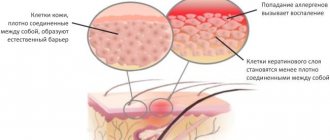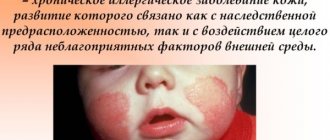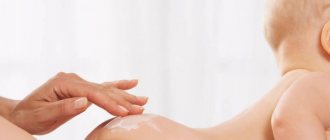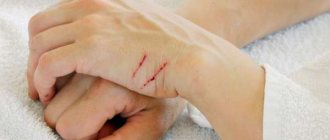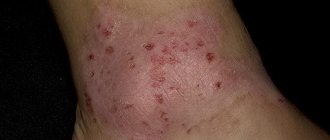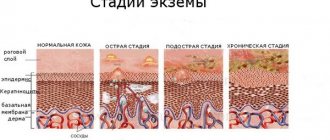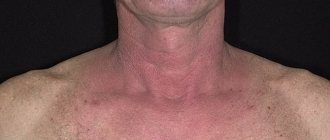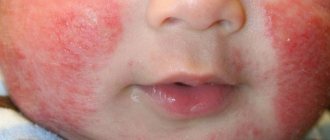How to recognize atopic dermatitis?
There is an opinion that the disease is transmitted by bottle-fed children, but this is a myth, since the percentage of dermatitis in breastfed babies is rapidly growing. Timely diagnosis will allow you to easily get rid of the first manifestations of the disease.
The main signs may be:
- Redness, itching, peeling: neck, cheeks, back, elbows and knees, buttocks
- Dry skin
- Getting wet
- Peeling of the scalp and face
- Nodular rash
- Local change in cover color
- Thin, sensitive skin, prone to cracks and damage.
A newborn will not be able to tell his parents about inconvenience or pain, so you need to pay attention to the baby’s behavior. In particular, on his mood, sleep and appetite. But many attribute the presence of these symptoms to diathesis.
Symptoms
The disease manifests itself not only by the appearance of rashes on the skin, but also by damage to the digestive, respiratory and other systems.
The main signs of allergic dermatitis in an infant:
- Hyperemia of the skin. The most common localization of the lesion is folds on the legs, arms, elbows, knees, face, neck, back, intergluteal fold.
- The appearance of rashes on the inflamed areas that look like pimples or blisters.
- Dryness, flaking of the skin, formation of crusts on the child’s head, as can be seen in the photo below.
- Itching of the affected skin.
- In severe cases, swelling of the mucous membranes of the eyes, mouth, nasal cavity, and upper respiratory tract develops. Clinically, these processes are manifested by allergic rhinitis, conjunctivitis or bronchial asthma. The most dangerous manifestation is angioedema, which requires immediate hospitalization of the child.
- Deterioration in the functioning of the digestive organs: regurgitation, diarrhea, constipation, change in stool color.
- The child’s well-being is impaired - moodiness, loss of appetite, sleep.
With continuous interaction with the allergen, lack of timely treatment and good care, areas of weeping and skin irritation appear. Purulent complications often develop due to the addition of a secondary infection.
Dermatitis or diathesis? How to distinguish diseases
In fact, the signs that appear are similar only at the initial stage.
Diathesis is the body’s tendency to allergic reactions , and a predisposition is not a disease. For the most part, once the irritant is eliminated, it goes away quickly . But dermatitis does not, it remains for a long time, in some cases for life.
There can be many reasons for the occurrence of dermatitis:
- Genetic predisposition (if one of the parents is allergic, then the risk of the disease is 40%).
- Presence of allergens in food. Proteins (found in cow's milk, eggs, grains, fish), pork and chicken, soy products, vegetables (carrots, beets, potatoes), fruits (grapes, citrus fruits, raspberries, strawberries, bananas, peaches), chocolate, honey, nuts.
- Irritants in the air. Dust, pollen, hair, pet dander, tobacco smoke, aerosols and substances with strong odors.
- Bacteria, viruses, fungi.
- Chemicals: soap, shampoo, creams (including diaper creams), oils, powders for washing clothes.
- Fabrics: wool, silk, linen.
- Psychological trauma (conflict situation in the family).
- Smoking, drinking alcohol and taking medications during pregnancy can also cause the disease.
If it becomes clear that the child has dermatitis, then special care will be required for him.
Diagnostics
Prescribing effective treatment requires timely diagnosis of the disease, clarifying its form and identifying the etiological factor. To quickly make a correct diagnosis, you should consult a dermatologist or allergist.
It is usually enough for a doctor to conduct a survey of parents to collect a complete history of the disease and the child’s life, detailing the existing risk factors for the development of allergic dermatitis. To confirm the diagnosis and differentiate it from other pathologies, additional research methods may be required:
- general, biochemical blood test;
- stool examination for dysbacteriosis, scatological examination;
- Ultrasound of the abdominal organs, kidneys, pelvis;
- conducting allergy tests;
- study of immune status.
Proper care for a baby with atopic dermatitis
Increased hydration of the affected areas of the skin is necessary; it is better to choose creams and lotions with nutrients. But do not forget that the chosen products must be hypoallergenic. The market offers lines for allergy sufferers, which include not only skin care products, but also washing powders, shampoos, and bath gels. All of them are aimed at moisturizing and preventing the skin from drying out.
The child should be bathed in filtered clean water (without a washcloth); if the pediatrician allows, you can add herbal infusions. But bathing shouldn't be a daily ritual.
Walking in the fresh air, a normal microclimate in the family, and good, sufficient night and daytime sleep are recommended.
Treatment
Treatment for toxicoderma should be carried out strictly under the supervision of a doctor, especially when it comes to the appearance of dermatitis in childhood.
First, medications are prescribed that do not contain all substances that can cause an increase in the allergic reaction in the patient. At the same time, diuretics and laxatives are prescribed. These substances will speed up the removal of allergen residues from the body. For children, such drugs are prescribed in the form of enemas.
For toxicoderma, treatment should include desensitizing therapy. Therefore, in parallel with the main medications, the patient is prescribed antihistamines, as well as a complex of vitamins, excluding group C.
If the disease is in an advanced stage, the doctor prescribes corticosteroids. Treatment at home will no longer work. Such a patient is admitted to a hospital.
The treatment course against toxicoderma also includes substances for external treatment of the skin. These may be aqueous solutions based on zinc or ointments based on corticosteroids.
But it is very difficult to get rid of this disease using only drug treatment. For a complete recovery, the patient needs to follow a certain diet.
Spices should be excluded from the diet of a patient with toxicerma
Treatment of atopic dermatitis in infants
It is possible to cure atopic dermatitis with an integrated approach . There are several methods of therapy:
Non-drug
First of all, it is necessary to eliminate all allergens in the diet. A nursing mother should change her diet. For formula-fed children, it is better to switch to dairy-free formulas and eliminate cow's milk. It is also necessary to review baby care products for washing clothes; all of this should be hypoallergenic. Again, there will be a need to control the temperature and humidity in the house. The optimal temperature is not lower than 22 degrees with a humidity of 50-70%.
Medication
If the above measures do not help, drug therapy is prescribed, which in turn comes in two types: local and systemic approach.
Local consists of applying creams and ointments to the affected areas of the skin (only as prescribed by a doctor):
- Anti-inflammatory ointments contain substances that prevent the inflammatory process.
- Antimicrobial creams contain antibiotics and antiseptics that destroy bacteria on the surface of the skin.
- Wet compresses using antibiotics and antiseptics.
Systemic therapy consists of taking medications:
- Antibiotics are aimed at destroying and removing pathogenic bacteria from the body.
- Antihistamines help reduce the allergic reaction.
- Glucocorticoids (hormonal drugs) can quickly reduce the external manifestations of the disease, but are not intended for long-term use. The recommended course is no more than two weeks.
- Sedatives calm the nervous system and have a mild hypnotic effect.
ethnoscience
Treatment with folk remedies can also become a real lifesaver. But before using even the most harmless herbal preparations, you must consult your doctor!
According to doctors, recipes for preparing baths, ointments, and infusions from natural remedies are best used as an additional aid to treatment, as well as in moments of exacerbation of symptoms. But it is unacceptable to use it as the only type of therapy, without consulting a doctor.
Signs of the disease
The main symptoms of atopic dermatitis are severe itching and skin changes.
At the age of 2-3 years (stage of infancy), the skin is swollen and red, small blisters and weeping appear, which then peel off and form crusts. The rashes are localized on the head under the hair and neck, on the forehead and cheeks, in the groin folds, on the buttocks, on the extensor surfaces of the arms and legs, and sometimes on the torso. Due to inflammation, the surface layer of the skin thickens, folds and small cracks form. Then atopic dermatitis moves into the next stage - the childhood stage. At this stage, the disease is characterized by a persistent course. The rash is most often located on the elbows and popliteal folds, in the armpits, on the flexor surface of the shoulder, the back of the hands, on the ankle joints, and in the neck area. Changes may appear on the lips and earlobes. The rashes are drier than in the first stage.
Beginning in adolescence (adult stage), the rash spreads to the areas of the flexor surfaces of the joints and hands, around the mouth and eyes, on the chest and neck.
You can learn more about the skin manifestations of the disease from the video:
At each stage, skin changes are accompanied by painful itching, burning, tingling and even pain. Itching in areas of skin lesions is especially painful. Itching prevents sleep or the patient wakes up from it in the middle of the night. Heat, dry air and sweat increase itching, which often does not respond to antiallergic therapy. Scratch marks can become infected and the wounds begin to fester. A painful and incessant itching prevents sleep, which is why the child becomes capricious, easily excitable, and often cries. Adult patients become irritable, sometimes aggressive, and in some cases apathetic.
Reliable and effective recipes for atopy for infants:
- Herbal baths.
- Pour boiling water over four tablespoons of chamomile (per liter) and let steep for 2-3 hours.
- One tablespoon of string per glass of water brought to a boil, leave for 15 minutes.
- For a glass of hot water, one spoon of starch (potato or rice), stir well before use.
- Dissolve five tablespoons of salt (sea salt) in the prepared bathtub.
- Infuse a handful of nettles . Attention! The permissible bath time is no more than 10 minutes.
- Boil 5 tablespoons of sage for about 30 minutes. Let it brew for 2 hours (store the finished infusion in a cool place).
- Compresses
- Mix equal parts freshly squeezed celery juice with apple cider vinegar, add a pinch of salt (table salt). Apply lotions to the affected areas for 5 minutes every two hours. If the condition worsens, apply in a course of one week.
- Brew 3-4 bay leaves. Apply the resulting solution to the child’s skin for two weeks.
- Infuse a small amount of calendula flowers and apply to problem areas.
- Compress to relieve itching. Apply a lotion with potato juice to the affected areas and leave overnight. The procedure is carried out once a day until the condition improves.
- Make a mixture of herbs in equal proportions (celandine, St. John's wort, yarrow), brew with boiling water, let it brew. Make lotions from the strained and cooled broth onto the affected areas.
- Mix hops and a teaspoon each, cook in 150 ml of water over low heat for 10 minutes. Leave for 2 hours out of reach of light.
- For drinking.
- Take 5 ml of fresh celery juice 15 minutes before meals. The course of administration is 2 times a day for a week.
- Prepare an infusion of hops in a ratio of 1 to 4. Drink 50 ml before meals. Attention! It may cause side effects (vomiting and nausea).
- 5 tablespoons of viburnum per liter of water (leave for 24 hours). Drink one glass a day, not in large sips, for two weeks. Contraindicated for children under six months of age.
- Ointments
- Combine 10 ml of St. John's wort juice with 20 grams of melted butter. Apply the resulting ointment to the affected areas at least 2 times a day. Store the finished product in a cool place.
- Mix calendula juice with lanolin in a ratio of 1 to 10.
- Combine baby powder with 30 grams of white clay. Apply for 20 minutes 3-4 times a day. After use, moisturize the skin with nourishing cream.
- Mix two tablespoons of sea buckthorn oil with a quarter cup of animal fat. Store in a cool place.
- Rubbing the skin with aloe vera juice.
Feedback from parents about traditional medicine is not clear. Most people agree that these recipes will only help alleviate the baby’s condition, but they cannot do without medications.
Diet for toxicoderma
Maintaining proper nutrition during treatment for toxicoderma plays a very important role. A complete overhaul of your daily diet will reduce your allergic reaction. The list of prohibited products should be compiled by the attending physician. He does this based on the test results obtained and the patient’s symptoms.
But there are foods that are excluded from the diet of any patient. After all, they are included in the list of the most allergenic foods:
- citrus,
- eggs,
- hot spices,
- sweet confectionery,
- nuts,
- certain types of fish,
- milk and cream,
- mushrooms.
It is also not recommended to consume products that include:
- artificial colors,
- flavorings,
- preservatives.
In the first week of treatment, you should consume only dairy dishes and products of plant origin. After this, you can add chicken or rabbit meat, as well as lean fish, to the menu. These products are found in minimal portions. Drinking should be plentiful. Do not make strong tea or drink drinks containing caffeine. It is best to give preference to still mineral water and weak green tea.
As a result, the entire diet should consist of buckwheat, rice and oatmeal, low-fat fermented milk products, yellow and green fruits, broths cooked with lean meat. People who often suffer from allergic reactions should refrain from consuming large amounts of salt and sugar.
All food should be steamed or boiled. Fried and baked foods will only make the situation worse. Before cooking the cereal, it is recommended to soak it in cold water for about 10–12 hours. It is advisable to boil the meat twice, the water should be changed.
Eggs, a strong allergen
Alternative medicine for atopic dermatitis
also another way to recovery from atopic dermatitis, related to alternative medicine.
Many psychologists claim that all diseases arise from negative thoughts. This opinion is shared by the American psychologist who developed her own program for getting rid of various diseases, Louise Hay. In his book “Heal Yourself” he says that all skin diseases are caused by negative thoughts and emotions : fear and anxiety.
The author suggests using harmonious affirmations as healing, convincing yourself of confidence and self-love. There is a whole treatment program developed by Louise. In her opinion, after completing the full course, which takes one year, complete recovery occurs. Opinions about the effectiveness of her program cause a lot of controversy, especially among doctors who look at this method rather skeptically.
However, it is difficult to argue that constant stress can not only aggravate the course of any disease, but also provoke exacerbations of chronic diseases, which include atopic dermatitis. Therefore, no matter how you feel about alternative medicine and treatment using affirmations, spells and other “magical” manipulations, you should not only use medications in the treatment of atopic dermatitis, but also provide a calm, friendly atmosphere.
Causes
Toxic dermatitis does not affect every person. Predisposing factors are necessary for its occurrence. They increase sensitivity in humans:
- Genetic predisposition. This disease is inherited. If parents suffer from this allergy, then 90% of the child will be born hypersensitive. In order to save the child from this problem, the mother must maintain proper nutrition from the moment of conception until the end of breastfeeding. The child also needs to create a hypoallergenic lifestyle and eliminate foods that are allergenic.
- Poor environmental conditions. People living in heavily polluted areas are more likely to suffer from allergenic diseases. Polluted air, water and soil have a bad effect on the human body, making it vulnerable to various bacteria and allergens.
- Failure to comply with proper nutrition of a woman during pregnancy. Even a healthy mother can give birth to a child with toxicoderma. The reason for the development of this disease is the consumption of allergenic foods. These include citrus fruits, exotic fruits, any sweet foods, nuts and fatty meats. It is advisable not to consume this food during pregnancy; it is best to include fresh vegetables, light soups and cereals in your diet.
- In adults, toxicerma can appear as a result of a chronic disease, with various abnormalities in the functioning of the digestive system, with a deterioration of the immune system, or with hormonal imbalances.
- If you use medications for a long time, drug toxicity occurs. The appearance of signs of this disease appears due to the use of antibiotics, barbiturates, amidopyrine, sulfonamides, halogens and tranquilizers. And also when using vaccines and serums, vitamins, medicines containing organic arsenic, iodine, aminazine, ACTH, quinine compounds and other agents. Sometimes drug toxicity develops due to antihistamines and corticosteroids.
- Allergic toxicoderma often appears in people who are in close contact with irritants, namely medications, chemicals, and household chemicals.
If a person has never suffered from an allergy, this does not mean that he is not at risk of it. You should always pay attention to your body and, at the first suspicious symptoms, consult a specialist.
Excessive consumption of nuts during pregnancy can lead to dermatitis in the baby

